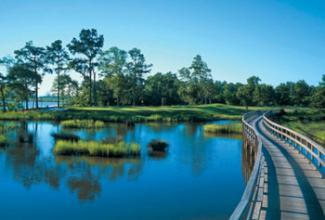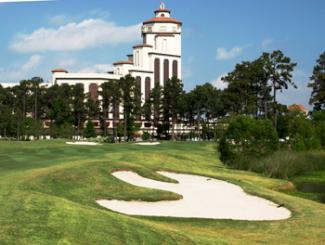Featured Golf News
Golf in SW Louisiana Has Distinct Cajun Flair
When one thinks of southwest Louisiana, linked pairs of images may come to mind: saints and hurricanes; Cajun and Creole; swamps and bayous; accordions and washboard percussion; relaxation on the back porch and raucous festivals; boudin and gumbo; fishing and hunting.

Lake Charles
Thanks to a growing roster of casinos in the area - most of them built to lure Texans to slot machines, craps tables and roulette pits, the last decade has spawned another duo of associations: gaming and golf, two things that seem, in modern times anyway, to go hand in hand.
In the past two decades the gaming industry has taken a strong hold in greater Lake Charles, stretching all the way back to the Texas border some 30 miles to the west in IH-10. The southwest Louisiana region is less than a two-hour drive from Houston, the fifth-largest metropolitan area in the U.S., and many of these casinos have distinctive themes that make Texans feel like they own the place.
The golf courses built in Lake Charles and environs since gaming was reintroduced in 1991 also have the feel of the layouts in the Lone Star State's coastal areas, adding to the familiarity factor for visitors from the west.
But because this is southwest Louisiana, there's a distinct take on just about everything - and that's a good thing. Call it a Cajun flair if you want; golf in SWLA is just a little more intense.
Golf Before Gaming
The Lake Charles area has seven golf courses, four that were built before the return of gaming and three since 1999.
Lake Charles Country Club, opened in 1918 as a nine-hole course, was the first place to play golf in the area and is still essentially a private facility. Pine Shadows Golf Course is the oldest public track in the area, opened in Lake Charles in 1940. Then came Frasch Golf Course in Sulphur (about 10 miles west of Lake Charles) in 1955, a course that has, at times, been rated among the state's best.
But the golf options took an upward tick in 1976 with the debut of Mallard Cove Golf Course just southwest of the main runway at the now-shuttered Chennault Air Force Base.

Mallard Cove GC
Designed originally by Jim Wall, a former associate of Robert Trent Jones, on a decided flat piece of land, Mallard Cove GC now boasts a championship layout with water entering play on 12 holes. Renovated in 2001 by Kevin Tucker, the course measures 6,977 yards from tips and plays to a par of 72 on a routing that also involves 25 large bunkers and stands of cypress, oak and pines. It has a course rating of 73.0 and a Slope of 128.
The back nine at Mallard Cove (www.cityoflakecharles.com/department/?fDD=10-0) demands excellent play and focus, with the closer one of the area's best tests. The big dogleg-right features a fairway bordered by a horseshoe-shaped pond and a strip of land up the middle. The pond continues down the right side with a heavily wooded area at the far right of the pond. It's often been the deciding juncture in the Lake Charles Men's City Championship, as many contestants have lost the tournament here by taking the maximum amount of risk off the tee and not finding dry land.
Mallard Cove's design and ever-present winds cause the course to present itself from a much different perspective nearly every day. Because of the risk-reward factor on five holes (four on the home half) players can make it as easy or hard as they want.

Gray Plantation
Gaming Begets Great Golf
As folks flocked to the region to live and to play, courses were built to keep visitors occupied when they weren't at the tables or in front of the slots. The first course after the gaming boom is Gray Plantation, the centerpiece of an upscale, gated community located just south of Lake Charles along the Calcasieu Waterway.
Opened in 1999 and renovated in 2005 after it suffered damage from Hurricane Rita, Gray Plantation (http://graywoodllc.com/grayplantation_home.html) is now a beautifully landscaped 7,200-yard semiprivate layout that challenges pros and entertains amateurs of all skills. The course was designed by William "Rocky" Roquemore, who allowed the natural beauty of Louisiana's Bayou Country and led Golf Magazine to describe it as "a delicate mix of Southern charm and Cajun fire."
Water, both from the adjacent Calcasieu and the course's 60 acres of manmade lakes, adds to the difficulty while contributing to the aesthetics. The wet stuff enters play on 11 of the course's 18 holes.
Besides all the aqueous hazards there are 94 bunkers, but few forced carries off the tee. Most of the trouble can be avoided with conservative play as Roquemore put an emphasis on tough par-3s, creating two with island-like greens.
The sixth is Gray Plantation's signature hole, a 168-yard par-3 with the smallest green on the course perched on a land spit surrounded on three sides by water. If the tide is out, it seems like you can walk from tee to green through the bog; the hundreds of drowned golf balls in the shallow, murky water tell you just how hard this hole can play.
The 11th features a split fairway with a lake in the middle, but the right-side portion is only 15 yards wide and closer to the water than the left. Brave souls can go for the green, but it's a 260-yard carry over the lake.
Nature also provides natural wildlife that calls the bayous around Gray Plantation home. Golfers are likely to spot wood ducks, egrets, alligators, deer and an occasional fox on the edges of the marshland.
Gray Plantation is a charter member of the Audubon Golf Trail in Louisiana. The Trail is named for naturalist/artist John James Audubon who, enchanted by the natural beauty of Louisiana, painted a number of his famous bird studies here. Coincidentally, all the courses are members of the Audubon Cooperative Sanctuary for Golf Courses, a program dedicated to protecting the environment and preserving the natural heritage of golf.

Contraband Bayou GC
Contraband Bayou Golf Club was the next course to come on line, opening in late May 2005 with an official unveiling in August of that year.
But the opening was delayed when Hurricane Katrina roared into Louisiana at the end of August. Then Rita struck and undid a heap of the work architect Tom Fazio and his team had labored over. Because the highest elevation on the course is a mere 14 feet above sea level, the storm tried to return much of the property to its origins. The course lost about 1,200 60-foot trees and most of the underbrush to the hurricanes.
The 7,077-yard, par-71 Contraband Bayou (www.llakecharles.com/amenities/golf-course) employs the marsh and lowland features. The site, across the street from the massive L'Auberge du Lac Casino Resort and built atop 227 acres that were once an underwater part of the Calcasieu Waterway, presented many obstacles in its design and construction, the toughest of which was building a golf course in swamp-like terrain.
More than 400,000 cubic yards of dirt were moved during construction of the only public course by Fazio in the Pelican State. There are plenty of favorable bounces incorporated into the par-3s (none over 200 yards), long par-4s (two play more than 450), short par-4s (three less than 375 yards) and a monster par-5 (the 611-yard opener).
Also involved are eight lakes. In the summer of 2010, Contraband Bayou GC's putting surfaces were revamped to Champion Ultradwarf Bermuda, and the layout was restructured, with the first hole repositioned in front of the clubhouse to improve flow.

National Golf Club of Louisiana
The newest course in the area might be the best. About five miles as the crow flies north of Contraband Bayou and a 15-minute drive around Lake Charles and back into the woods is the National Golf Club of Louisiana, a big-shouldered Dave Bennett design. Opened in August 2009, the layout is the centerpiece of a new 600-plus-acre master-planned neighborhood in Westlake, a town just above Lake Charles.
Bennett's 6,946-yard layout features 14 lakes, 80 bunkers and some of the area's largest and toughest greens. Stately Louisiana pines and dramatic vistas are highlights. National's fairways are generously wide, but gentle slopes and rolling fairways can be unforgiving, so be precise with your tee shots.
The National Golf Club of Louisiana went through more than 10 years of planning and countless hours of work. There's a lot to like about what Bennett fashioned at a course with a 73.5 rating and 132 Slope. Each of its four par-5s (the longest of which is 537 yards) are reachable with a pair of good shots, and the collection of par-3s (159, 192, 176 and 199 yards, respectively) offer the opportunity to use a variety of clubs off the tee.
What makes the National (www.nationalgcla.com) really worth the trip are its two-shotters, the best of which are the 433-yard third, the 433-yard 10th (despite being the same length, they dogleg in opposite directions), the 457-yard 16th (the No. 1 handicap hole) and the finisher - a 415-yard dogleg-left with water on the right and a green pinched on each side by sand.
Plenty to Do in SWLA
Lake Charles is about casino gaming and the great outdoors, culinary delights and the Rhythm and Blues that make Louisiana so exotic. It also offers historical sites, luxury hotels and accommodations, a subtropical climate and warm Southern hospitality.
The Creole Nature Trail, a 186-mile stretch of roadway that starts in Sulphur and ends in Lake Charles, is a haven for alligators, birds and wildflowers. International bird-watchers consider the trail, known as "Louisiana's Outback," a prime destination.
Lake Charles has earned its nickname the "Festival Capital of Louisiana" for hosting more than 75 fairs and festivals annually. Check out www.visitlakecharles.org for dates of upcoming events.
Steve Habel is a freelance writer contributing Cybergolf news stories, features, equipment and book reviews and personality profiles from his base in Central Texas. He also works as a contributing editor for Horns Illustrated magazine, a publication focusing on University of Texas sports, and is a contributing writer for Golfers' Guide and Golf Oklahoma magazine, Texas Links magazines and Golfers Guide. Habel's main blog (www.shotoverthegreen.blogspot.com) features news on golf and the Longhorns, and another (www.checkinginandplayingthrough.blogspot.com) chronicles his many travels, including playing more than 600 golf courses since 2008. Habel is a member of the Golf Writers Association of America and the Texas Golf Writers Association.
Story Options
 |
Print this Story |
